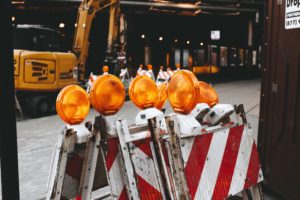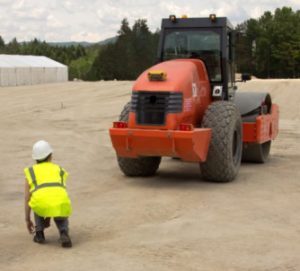
Keep reading to learn what actions you can take to protect road workers from on-the-job dangers:
1. Control Traffic Outside of Work Zones
Passing traffic can present some of the biggest hazards for road workers, with more than 1,500 collisions taking place each year between motorists and workers in construction zones across Canada.
If crews are going to be exposed to traffic-related dangers, you must prepare a written traffic protection plan that:
- Clearly identifies work areas with devices like signs that effectively alert the public, are clean and well-maintained, and are positioned according to the specifications outlined in the Ontario Traffic Manual Book 7.
- Keeps the public out of work zones using different tools including barricades, barriers, and crash trucks depending on factors like how long you’ll be working at the site, how much you encroach on the roadway, and set speed limits in the area.
- Provides passing drivers, cyclists, and pedestrians with clear directions about how to get through or around the work zone. Signage should let people know that a diversion is coming so they’re prepared to take an alternate route. Local authorities might be able to offer assistance too by temporarily decreasing maximum speeds and sending officers for additional reinforcement.
There have also been a number of campaigns launched in recent years to improve public awareness about road safety issues. These include the Ontario Road Builders’ Association’s 2012 campaign and Thunder Bay Hydro’s “Hit the Brakes…NOT US” initiative from 2009.
2. Keep Crews Safe in Work Zones
Work zones themselves can also be accident-prone places, with interactions between workers and other objects like equipment being the most common type of incident in Ontario.
You can reduce risks for in-zone accidents by:
- Separating road workers from moving equipment, particularly large trucks, as often as possible with the correct signage, designated worker-only areas, and safe pathways.
- Follow the “see and be seen” rule, which says that there should always be visual contact between workers on the ground and those in the equipment. Equipment operators should always do a 360-degree check before they begin moving.
- Keep flaggers safe by both limiting their use whenever possible and ensuring they’re properly trained to identify and respond to hazards.
To read more about keeping road workers safe, check out “Safe Work on the Road” in the Infrastructure Health & Safety Association’s Health & use Safety Magazine.
3. Use Safety Technology like Proximity Warning Systems
A worksite can be a hectic environment and, although people do their best to remain vigilant at all times, unfortunately accidents still happen. The right safety technology can serve as a second set of on-the-job eyes, helping operators constantly monitor their surroundings and letting them know about possible dangers.

The pedestrian detection system, the first of its kind and an innovation unique to Blaxtair, uses a smart camera and sensor to continuously scan areas around the vehicle or machine and reconstruct the environment in 3D. Its built-in algorithms can distinguish a person from another object and, if it detects someone present in the danger zone, it can alert the operator so they can stop with plenty of time to spare and prevent a collision.
Do you want to learn more about how Blaxtair’s safety solutions can protect the people on and around your working environment? Contact Amaco today to talk to an equipment expert!
4. Make Sure Road Workers Always Wear Proper Personal Protective Equipment (PPE)
In Ontario, necessary PPE includes:
- Class E hard hats
- CSA-certified Grade 1 safety boots
- Reflective vests or clothing
- Eye and hearing protection (when the situation requires it)
Wearing high-vis equipment like retroreflective armbands, vests, and hats is especially critical in situations with poor visibility.
5. Ensure Workers Are Fully and Correctly Trained
Safety practices like traffic protection plans often vary between jobs, which is why it’s important to educate new workers about site-specific procedures. You should also regularly reinforce the rules through safety-oriented events and day-to-day conversations to ensure everyone is on the same page.
For workers who will be using equipment, it’s important to keep manuals handy and quickly accessible so that they are easy to consult when necessary.
6. Inspect, Repair, and Maintain Your Equipment
Well-maintained equipment not only works better and runs more efficiently, it also makes the jobsite a safer place to be for operators and ground crews alike:
- Maintain accurate logs of any work you do. If the same problem crops up in the future, you’ll know precisely how to handle it.
- Create a service parts list that includes common items like fluid and air filters. Keeping this type of resource on file with a preferred vendor will make re-ordering parts easy and hassle free.
- Keep equipment surfaces, especially floor decks, clean and free of obstacles. You might have to use more aggressive techniques like power washing or steam cleaning to get rid of spills caused by excess grease or hydraulic leaks.
Operators should always perform walk-around inspections before starting or moving their equipment, and any damaged components should be repaired or replaced before the machines are allowed back on the jobsite.
Taking the right steps to keep crews safe and equipment in good shape will help you maximize on-site safety, productivity, and efficiency.
Whether you’re looking for a specific wear part or ongoing replacement parts, our warehouse of warranty-approved OEM parts and in-house specialists have you covered. Contact Amaco today for any parts and service inquiries.
Read more from Amaco:
- Welcome to Our New Website!
- Avoid Surprises in Your Municipal Heavy Equipment Budgets Next Year (3 Essential Tips You Need to Know)
- The Power of Automation in the Heavy Equipment Industry
- 8 Questions To Ask When Buying Used Aggregate Equipment - June 16, 2025
- 5 Key Steps to Choosing the Right Curb Machine for Your Fleet - October 22, 2024
- 5 Tips for Purchasing Used Excavating Equipment in Ontario - September 26, 2024

